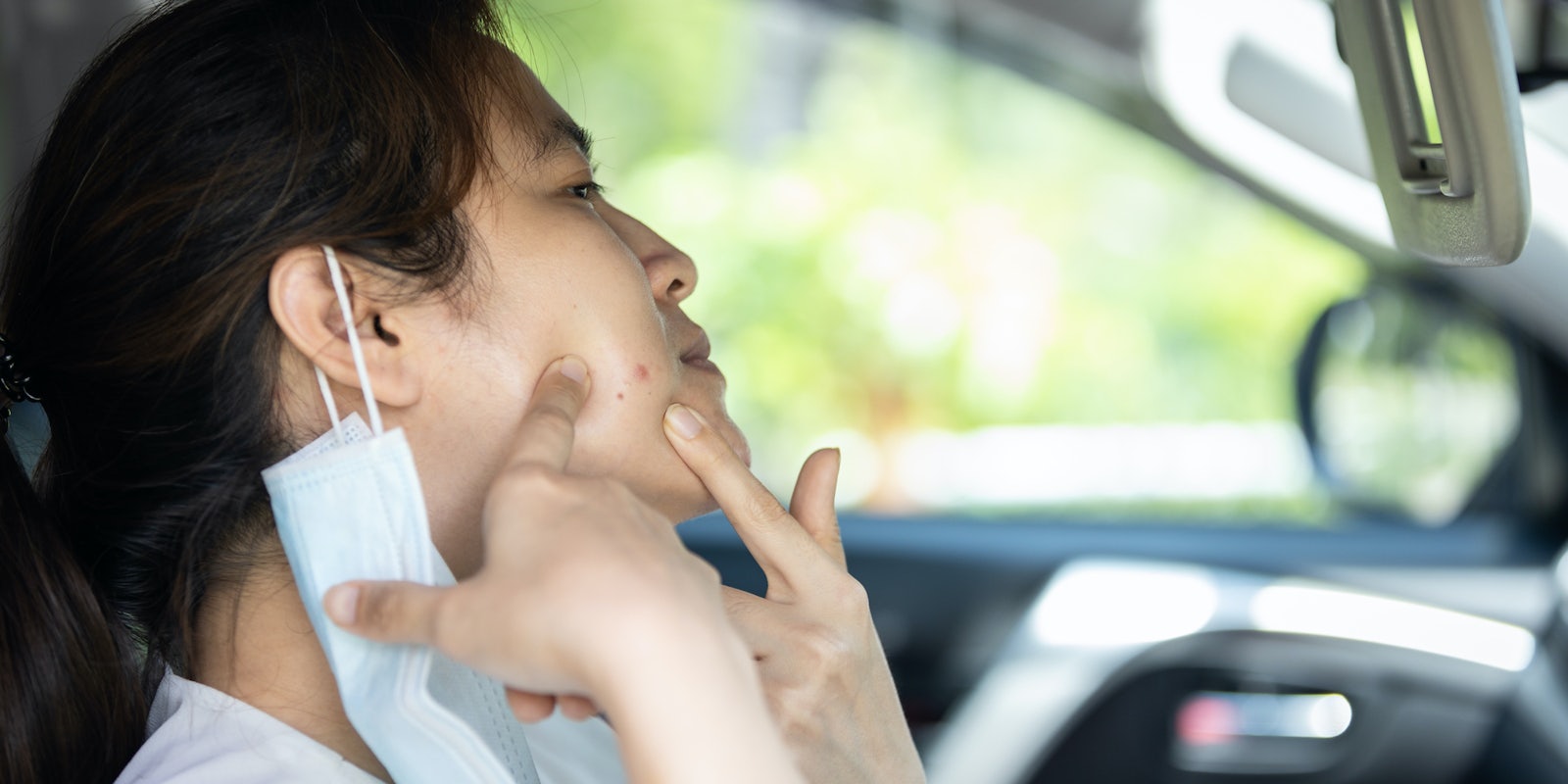Whether you’re rocking a surgical mask or a cloth mask these days, you may have noticed you’re facing a new problem: mask acne. Also known as “maskne,” this can happen when you wear a mask for long periods of time. If you’re frowning at your mirror over these unwelcome eruptions, fear not. There are ways to manage this unattractive issue. But in the meantime, hey––at least you have to cover it when you go out anyway.
What is mask acne?
Defined in medical terms as acne mechanica, mask acne happens due to a combination of factors. Since the mask presses against your face and you’re breathing against it, the environment inside it is humid. It also moves slightly during wear which causes more friction. The skin can also become dry, itchy, and raw because of this. It’s also a recipe for clogged pores (yuck).
Mask acne is not the only skin issue that pops up with consistent mask wear, either. Some masks contain chemicals that can irritate sensitive skin (such as formaldehyde and bronopol). Rosacea sufferers will also struggle with wearing masks since heat exacerbates the condition.
How to prevent mask acne
1) Get clean
A big part of avoiding mask acne is prepping your skin beforehand. Obviously, the best first step is to wash your face. However, the way you wash your face matters. Choose a gentle cleanser with a low pH (our guide has some excellent suggestions here). Also make sure to wash your face in lukewarm water as hot water dries the skin out.
2) Moisturize
Next, apply a moisturizer that’s made for your skin type (or do your skincare routine which is even better). Adding this layer of moisture will help to condition your skin. Products that contain hyaluronic acid are an especially good pick since it delivers such a boost of moisture. You should slather hyaluronic acid all over your body as far as I’m concerned, but that’s another post all on its own.
3) Skip the makeup
I know glamour queens will hate to hear this, but wearing makeup under your mask is a really bad idea. Sorry, babes. As you know, going to sleep in your makeup causes breakouts. That’s because it clogs your pores if it’s on too long. So imagine wearing makeup, covering it up with a mask and letting it all simmer in a warm, moist pouch. Not good. Also, no one can see that part of your face anyway so the makeup is pretty much wasted. Just put on some mascara and call it a day.
4) Wear a clean mask
Common sense, right? WRONG. This can be proven by the molding masks you see hanging off the rearview mirrors of so many people’s cars. If you’re too lazy to wash a cloth mask, buy disposable surgical ones! Cloth masks need to be washed after each use (and preferably with fragrance-free detergent). This means you either need to buy a bunch or do laundry every other day. Yes, it’s inconvenient. So is trying to live life during a pandemic and not die.
How to treat mask acne
If you’ve already got mask acne and you need to treat it, do so with care. Throwing harsh treatments on already-irritated skin is a terrible idea. Don’t be mean to your face. Instead, try one of these solutions.
1) Switch to a low pH cleanser
I mentioned this earlier, but boy are high pH cleansers terrible for your skin. They cause skin to feel tight, which some people think of as “clean.” I think of it as uncomfortable. But that’s also because I know that tight-feeling skin also means that its moisture barrier is thrown way, way out of whack. This causes everything from irritation to acne and basically saps power away from the rest of your skincare routine. If your cleanser foams, it’s probably high pH and needs to be chucked into the trash. We have some terrific low pH options to suggest right here.
2) Use pimple patches for small breakout areas
I always have pimple patches on hand for when I get breakouts (which is not often these days, yay for good skincare!). These clever little guys are simply tiny circles of hydrocolloid, a wound care solution that’s been around since the late 60s. These days if you stick one to a pimple, it absorbs all the gunk out of it. Then you won’t be tempted to pop it which always leaves a scar behind anyway. They also protect your pimples as they heal, so wear them under your mask. Your skin will be looking better before you know it.
3) Call your dermatologist
If your mask acne goes beyond a few red spots and looks more like a rash, it’s time to call your dermatologist. In the meantime, wash or dispose of your mask depending on the type you use. But don’t stop wearing a mask! You should talk to your dermatologist and learn what’s causing the problem before tossing your mask altogether. Plus that’s a very unsafe idea right now unless you want to breathe COVID-19.
The Daily Dot may receive a payment in connection with purchases of products or services featured in this article. Click here to learn more.


